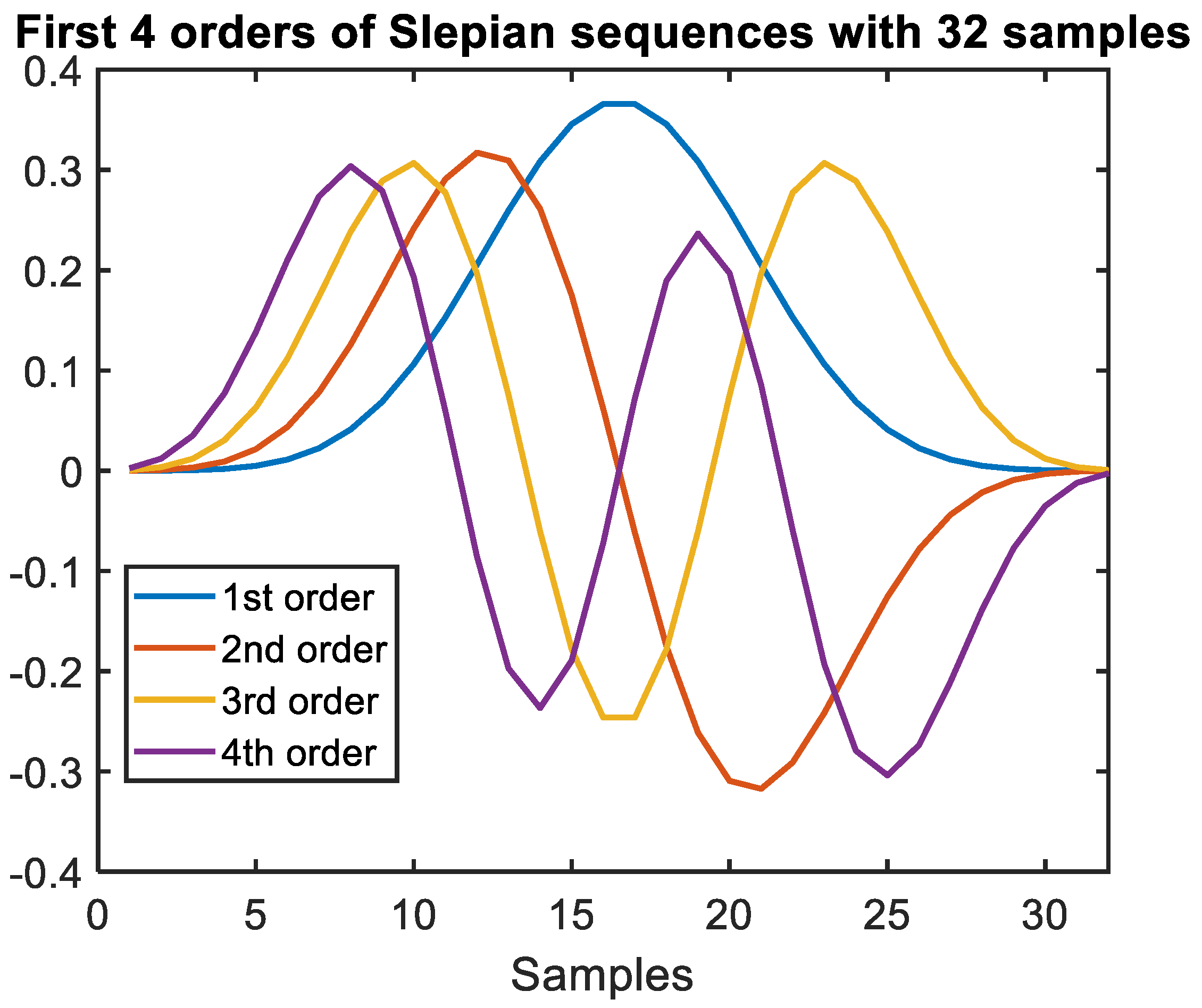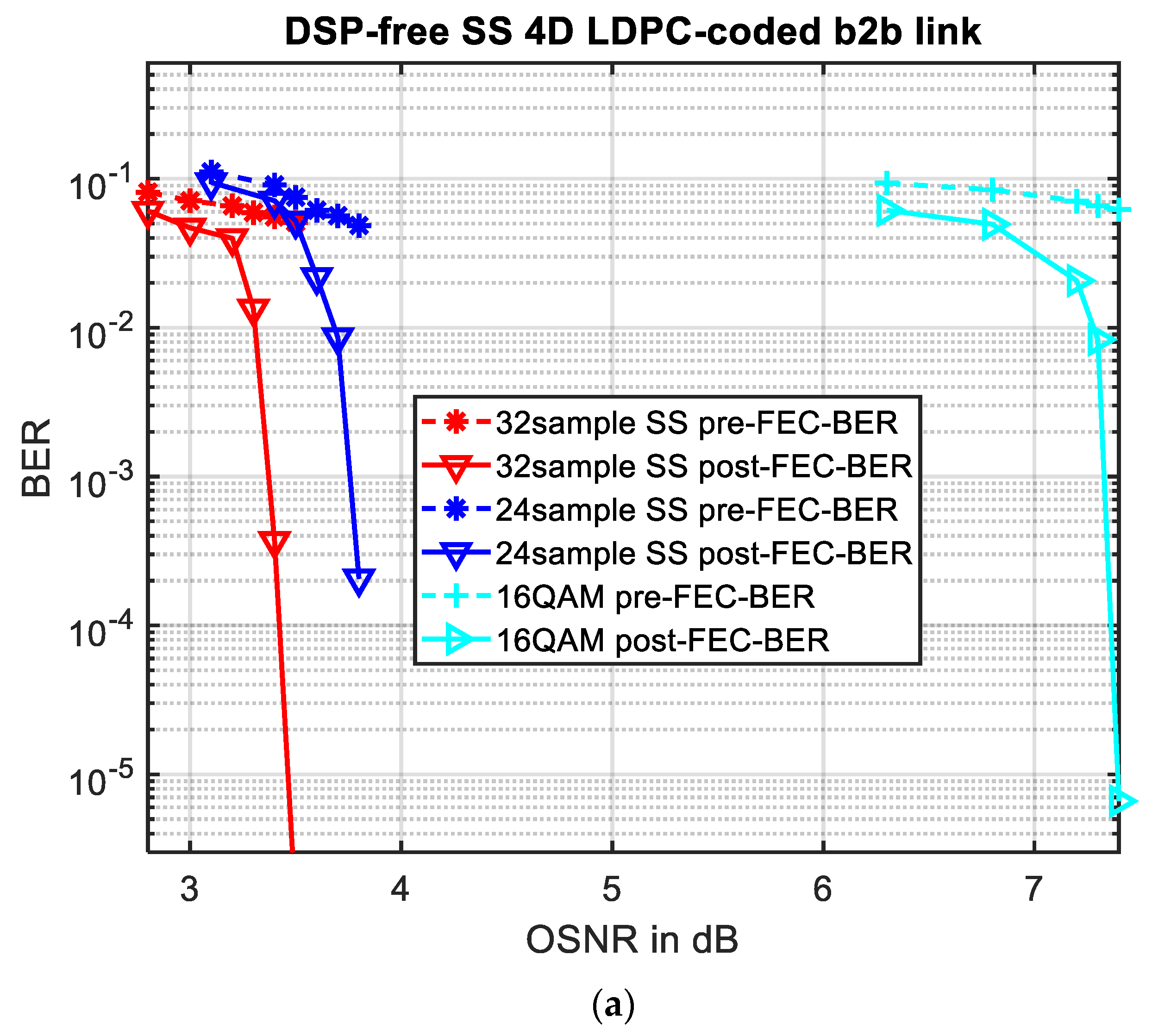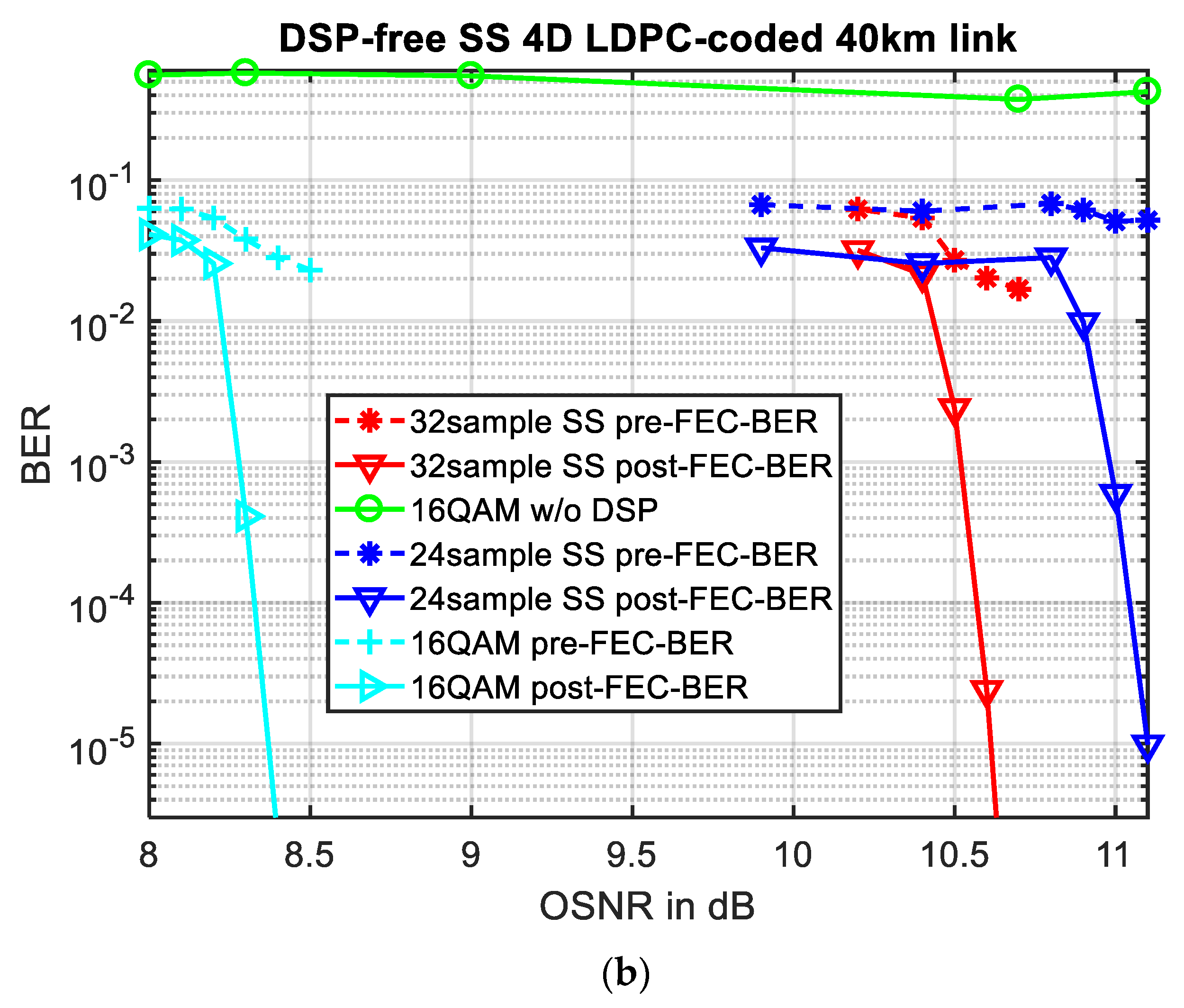Two-Dimensional Transmission of Four-Dimensional LDPC-Coded Modulation with Slepian Sequences for DSP-Free 40 km Metro Network Applications
Abstract
:1. Introduction
2. Proposed Slepian Sequences-Based 16-4D LDPC-Coded Modulation Scheme
3. Experimental Setup and Experimental Results
4. Concluding Remarks
Author Contributions
Funding
Institutional Review Board Statement
Informed Consent Statement
Data Availability Statement
Conflicts of Interest
References
- Djordjevic, I.B.; Saleh, A.H.; Küppers, F. Design of DPSS based fiber bragg gratings and their application in all-optical encryption, OCDMA, optical steganography, and orthogonal-division multiplexing. Opt. Express 2014, 22, 10882–10897. [Google Scholar] [CrossRef] [PubMed]
- Djordjevic, I.B. Slepian-FBGs-Based Optical Covert Communications. In Proceedings of the 2018 IEEE Photonics Conference (IPC), Reston, VA, USA, 30 September–4 October 2018. [Google Scholar]
- Djordjevic, I.B. On the energy-efficient multidimensional coded modulation for optical transport networks. In Proceedings of the 2014 IEEE Online Conference on Green Communications (OnlineGreenComm), Online, 12–14 November 2014. [Google Scholar]
- Tan, M.; Corcoran, B.; Xu, X.; Wu, J.; Boes, A.; Nguyen, T.G.; Chu, S.T.; Little, B.E.; Morandotti, R.; Mitchell, A.; et al. Optical data transmission at 44 terabits/s with a Kerr soliton crystal microcomb. In Proceedings of the Society of Photo-Optical Instrumentation Engineers (SPIE), Online, 5 March 2021. [Google Scholar]
- Maniloff, E.; Gareau, S.; Moyer, M. 400G and Beyond: Coherent Evolution to High-Capacity Inter Data Center Links. In Proceedings of the Optical Fiber Communication Conference (OFC), San Diego, CA, USA, 3–7 March 2019. [Google Scholar]
- Bülow, H. Polarization QAM Modulation (POL-QAM) for Coherent Detection Schemes. In Proceedings of the Optical Fiber Communications Conference and Exhibition (OFC), San Diego, CA, USA, 22–26 March 2009. [Google Scholar]
- Winzer, P.J.; Gnauck, A.H.; Doerr, C.R.; Magarini, M.; Buhl, L.L. Spectrally Efficient Long-Haul Optical Networking Using 112-Gb/s Polarization-Multiplexed 16-QAM. J. Lightwave Technol. 2010, 28, 547–556. [Google Scholar] [CrossRef]
- Chen, B.; Alvarado, A.; van der Heide, S.; Hout, M.V.D.; Hafermann, H.; Okonkwo, C.M. Analysis and Experimental Demonstration of Orthant-Symmetric Four-Dimensional 7 bit/4D-Sym Modulation for Optical Fiber Communication. J. Lightwave Technol. 2021, 39, 2737–2753. [Google Scholar] [CrossRef]
- Chen, B.; Ling, W.; Gültekin, Y.C.; Lei, Y.; Okonkwo, C.; Alvarado, A. Low-Complexity Geometrical Shaping for 4D Modulation Formats via Amplitude Coding. IEEE Photonics Technol. Lett. 2021, 33, 1419–1422. [Google Scholar] [CrossRef]
- Han, X.; Yang, M.; Djordjevic, I.B.; Li, A. Probabilistically-Shaped Four-Dimensional LDPC-Coded Modulation in 100 km DWDM Optical Transmission for Metro Network Applications. In Proceedings of the Asia Communications and Photonics Conference (ACPC) 2019, Chengdu, China, 2–5 November 2019. [Google Scholar]
- Cai, J.-X.; Batshon, H.G.; Mazurczyk, M.V.; Sinkin, O.V.; Wang, D.; Paskov, M.; Davidson, C.R.; Patterson, W.W.; Turukhin, A.; Bolshtyansky, M.A.; et al. 51.5 Tb/s Capacity over 17,107 km in C+L Bandwidth Using Single-Mode Fibers and Nonlinearity Compensation. J. Lightwave Technol. 2018, 36, 2135–2141. [Google Scholar] [CrossRef]
- Johannisson, P.; Sjödin, M.; Eriksson, T.A.; Karlsson, M. Four-Dimensional Modulation Formats for Long-Haul Transmission. In Proceedings of the Optical Fiber Communication Conference, San Diego, CA, USA, 9–13 March 2014; p. M2C.4. [Google Scholar]
- Oliari, V.; Karanov, B.; Goossens, S.; Liga, G.; Vassilieva, O.; Kim, I.; Palacharla, P.; Okonkwo, C.; Alvarado, A. High-Cardinality Hybrid Shaping for 4D Modulation Formats in Optical Communications Optimized via End-to-End Learning. arXiv 2021, arXiv:2112.10471. [Google Scholar]
- Buchali, F.; Lauinger, V.; Chagnon, M.; Schuh, K.; Aref, V. 1.1 Tb/s/λ at 9.8 bit/s/Hz DWDM transmission over DCI distances supported by CMOS DACs. In Proceedings of the Optical Fiber Communication Conference (OFC), San Diego, CA, USA, 8–12 March 2020. [Google Scholar]
- Rashidinejad, A.; Nguyen, A.; Olson, M.; Hand, S.; Welch, D. Real-Time Demonstration of 2.4Tbps (200Gbps/) Bidirectional Coherent DWDM-PON Enabled by Coherent Nyquist Subcarriers. In Proceedings of the Optical Fiber Communication Conference (OFC), San Diego, CA, USA, 8–12 March 2020. [Google Scholar]
- Schadler, M.; Bocherer, G.; Pittala, F.; Calabro, S.; Stojanovic, N.; Bluemm, C.; Kuschnerov, M.; Pachnicke, S. Recurrent Neural Network Soft-Demapping for Nonlinear ISI in 800Gbit/s DWDM Coherent Optical Transmissions. J. Lightwave Technol. 2021, 39, 5278–5286. [Google Scholar] [CrossRef]
- Han, X.; Djordjevic, I.B.; Jovanovic, A.Z. Hybrid Probabilistic-Geometric Shaped LDPC-coded PM-16QAM in 140 km DWDM Metro Network Communication. In Proceedings of the Conference on Lasers and Electro-Optics (CLEO), Online, 9–14 May 2021. [Google Scholar]
- Chen, Y.-W.; Yi, S.; Ling, G.; West, B.; Zhao, L.; Way, W. Real-Time Demonstration of 75GHz-Spaced DWDM Single-Carrier 400G CFP2-DCO Over 1500 km. J. Lightwave Technol. 2021, 1. [Google Scholar] [CrossRef]
- Han, X.; Yang, M.; Djordjevic, I.B.; Yue, Y.; Wang, Q.; Qu, Z.; Anderson, J. Joint Probabilistic-Nyquist Pulse Shaping for an LDPC-Coded 8-PAM Signal in DWDM Data Center Communications. Appl. Sci. 2019, 9, 4996. [Google Scholar] [CrossRef] [Green Version]
- Tahir, B.; Schwarz, S.; Rupp, M. BER comparison between Convolutional, Turbo, LDPC, and Polar codes. In Proceedings of the 2017 24th International Conference on Telecommunications (ICT), Limassol, Cyprus, 3–5 May 2017. [Google Scholar]
- Yang, F.; Fang, J.; Xiao, S.; Chen, Z.; Hu, W. Shaped polar codes for dimmable visible light communication. Opt. Commun. 2021, 496, 127126. [Google Scholar] [CrossRef]
- Tanimura, T.; Yoshida, S.; Tajima, K.; Oda, S.; Hoshida, T. Concept and implementation study of advanced DSP-based fiber-longitudinal optical power profile monitoring toward optical network tomography. J. Opt. Commun. Netw. 2021, 13, E132–E141. [Google Scholar] [CrossRef]
- Fatadin, I.; Ives, D.; Savory, S. Blind Equalization and Carrier Phase Recovery in a 16-QAM Optical Coherent System. J. Lightwave Technol. 2009, 27, 3042–3049. [Google Scholar] [CrossRef]
- Civelli, S.; Forestieri, E.; Secondini, M. Interplay of Probabilistic Shaping and Carrier Phase Recovery for Nonlinearity Mitigation. In Proceedings of the 2020 European Conference on Optical Communications (ECOC), Online, 6–10 December 2020. [Google Scholar]
- Maeda, H.; Saito, K.; Kawahara, H.; Seki, T.; Sasai, T.; Hamaoka, F. High Spectral Efficiency Real-Time 500-Gb/s/carrier Long-Haul Transmission Over Field-Installed Fibers. J. Lightwave Technol. 2021, 39, 933–939. [Google Scholar] [CrossRef]
- Maeda, H.; Saito, K.; Sasai, T.; Hamaoka, F.; Kawahara, H.; Seki, T.; Kawasaki, T.; Kani, J.-I. Real-time 400 Gbps/carrier WDM transmission over 2,000 km of field-installed G.654.E fiber. Opt. Express 2020, 28, 1640–1646. [Google Scholar] [CrossRef]
- Hamaoka, F.; Sasai, T.; Saito, K.; Kobayashi, T.; Matsushita, A.; Taniguchi, H.; Kuwahara, S.; Kawahara, H.; Seki, T.; Ozaki, J.; et al. Dual-Carrier 1-Tb/s transmission over field-installed G.654.E fiber link using real-time transponder. IEICE Trans. Commun. 2020, E103-B, 1183–1189. [Google Scholar] [CrossRef]
- Sun, H.; Torbatian, M.; Karimi, M.; Maher, R.; Thomson, S.; Tehrani, M.; Gao, Y.; Kumpera, A.; Soliman, G.; Kakkar, A.; et al. 800G DSP ASIC Design Using Probabilistic Shaping and Digital Sub-Carrier Multiplexing. J. Lightwave Technol. 2020, 38, 4744–4756. [Google Scholar] [CrossRef]
- Mello, D.A.A.; Barbosa, F.A.; Reis, J.D. Interplay of Probabilistic Shaping and the Blind Phase Search Algorithm. J. Lightwave Technol. 2018, 36, 5096–5105. [Google Scholar] [CrossRef] [Green Version]
- Perin, J.K.; Shastri, A.; Kahn, J.M. Design of Low-Power DSP-Free Coherent Receivers for Data Center Links. J. Lightwave Technol. 2017, 35, 4650–4662. [Google Scholar] [CrossRef]
- Morsy-Osman, M.; Sowailem, M.; El-Fiky, E.; Goodwill, T.; Hoang, T.; Lessard, S.; Plant, D.V. DSP-free ‘coherent-lite’ transceiver for next generation single wavelength optical intra-datacenter interconnects. Opt. Express 2018, 26, 8890–8903. [Google Scholar] [CrossRef]
- Ciaramella, E. Assessment of a Polarization-Independent DSP-Free Coherent Receiver for Intensity-Modulated Signals. J. Lightwave Technol. 2019, 38, 676–683. [Google Scholar] [CrossRef]
- Kamran, R.; Nambath, N.; Manikandan, S.; Ashok, R.; Jain, R.; Thaker, N.B.; Gupta, S. Demonstration of a low-power, local-oscillator-less, and DSP-free coherent receiver for data center interconnects. Appl. Opt. 2020, 59, 2031–2041. [Google Scholar] [CrossRef]
- Verbist, J.; Lambrecht, J.; Verplaetse, M.; Van Kerrebrouck, J.; Srinivasan, A.; De Heyn, P.; De Keulenaer, T.; Yin, X.; Torfs, G.; Van Campenhout, J.; et al. DAC-Less and DSP-Free 112 Gb/s PAM-4 Transmitter Using Two Parallel Electroabsorption Modulators. J. Lightwave Technol. 2018, 36, 1281–1286. [Google Scholar] [CrossRef]
- Saber, G.; Morsy-Osman, M.; Hui, M.; El-Fiky, E.; Vall-Llosera, G.; Dortschy, B.; Urban, P.J.; Cavaliere, F.; Lessard, S.; Plant, D.V. DSP-Free 25-Gbit/s PAM-4 Transmission Using 10G Transmitter and Coherent Amplification. IEEE Photonics Technol. Lett. 2018, 30, 1547–1550. [Google Scholar] [CrossRef]
- Rannello, M.; Presi, M.; Ciaramella, E. Optical vs. Electrical Duobinary Coding for 25 Gb/s PONs based on DSP-free Coherent Envelope Detection. In Proceedings of the Optical Fiber Communication Conference (OFC), San Diego, CA, USA, 11–15 March 2018. [Google Scholar]
- Djordjevic, I.B. Proposal for Slepian-States-Based DV- and CV-QKD Schemes Suitable for Implementation in Integrated Photonics Platforms. IEEE Photonics J. 2019, 11, 1–12. [Google Scholar] [CrossRef]








Publisher’s Note: MDPI stays neutral with regard to jurisdictional claims in published maps and institutional affiliations. |
© 2022 by the authors. Licensee MDPI, Basel, Switzerland. This article is an open access article distributed under the terms and conditions of the Creative Commons Attribution (CC BY) license (https://creativecommons.org/licenses/by/4.0/).
Share and Cite
Han, X.; Djordjevic, I.B. Two-Dimensional Transmission of Four-Dimensional LDPC-Coded Modulation with Slepian Sequences for DSP-Free 40 km Metro Network Applications. Sensors 2022, 22, 1815. https://doi.org/10.3390/s22051815
Han X, Djordjevic IB. Two-Dimensional Transmission of Four-Dimensional LDPC-Coded Modulation with Slepian Sequences for DSP-Free 40 km Metro Network Applications. Sensors. 2022; 22(5):1815. https://doi.org/10.3390/s22051815
Chicago/Turabian StyleHan, Xiao, and Ivan B. Djordjevic. 2022. "Two-Dimensional Transmission of Four-Dimensional LDPC-Coded Modulation with Slepian Sequences for DSP-Free 40 km Metro Network Applications" Sensors 22, no. 5: 1815. https://doi.org/10.3390/s22051815
APA StyleHan, X., & Djordjevic, I. B. (2022). Two-Dimensional Transmission of Four-Dimensional LDPC-Coded Modulation with Slepian Sequences for DSP-Free 40 km Metro Network Applications. Sensors, 22(5), 1815. https://doi.org/10.3390/s22051815






